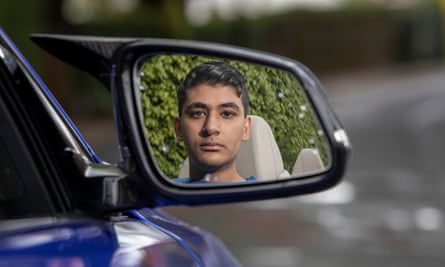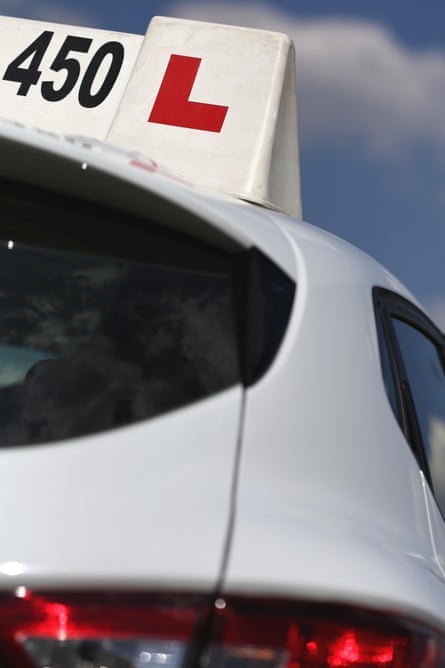I have just turned 17 and I face a dilemma: should I learn to drive? Gaining a driving licence is seen by many as a passage to adulthood and maturity: it represents freedom and can be a vital asset when looking for work.
But with school closures, lockdowns and the financial insecurities that my generation face, is it really worth spending money on lessons now?
According to the personal finance site NimbleFins, if you do not block book lessons the average cost across Great Britain is £27 an hour. Block bookings bring it down to £23. The Driver and Vehicle Standards Agency (DVSA) says the average learner takes 47 hours of driving lessons before passing their test. That adds up to between £1,081 and £1,269.
Got an electric car charger at home? Share it and earn cashRead more View image in fullscreenQais Hussain, 17, has weighed up the costs of learning to drive against the benefits. Photograph: Gary Calton/The Guardian
View image in fullscreenQais Hussain, 17, has weighed up the costs of learning to drive against the benefits. Photograph: Gary Calton/The Guardian
The cost of lessons varies because driving instructors are free to charge whatever they wish. I live in Bradford, and according to NimbleFins, the average cost in the region is £26. The closest company to me charges £28 an hour, while another local firm charges £29 an hour or £28 an hour if you are a student, which I am. For 47 hours’ lessons I would pay £1,316.
Another option that people take to pass their driving test is intensive lessons. These courses are typically one or two weeks long.
A lot of intensive driving courses are marketed as a guaranteed pass. But this could simply mean that you’ll be guaranteed a refund if you don’t pass, or more lessons with them until you pass. According to the RAC, a one-day course is likely to cost about £200 but this is only suitable for someone who requires a few hours’ practice before a test, not a learner. A week-long course can cost in the region of £1,000, while a two-week course could be double that.
My local driving school charges £860 for 40 hours of intensive lessons spread over two weeks, which works out to be £21.50 an hour, £6.50 less than a normal standard lesson. So an intensive driving course could work out cheaper for me.
However, on its website the AA advises against intensive driving courses: “Attempting to cram everything in at once isn’t necessarily an effective way to learn. Taking your driving lessons over a longer period, with a more structured approach and a clear lesson plan, will help you learn all the skills necessary for life on the road.”
Other critics point out that if you fail your driving test first time round you may have to wait several weeks before another slot becomes available – by which time you may have forgotten much of what you learned in the first place.
Lessons are only part of the cost I need to cover if I want to get on the road. The first step in the process of learning to drive is applying for a provisional licence. This costs £34 online at gov.uk and £43 by post.
 View image in fullscreenThere are a number of things to look at before a young driver can consider taking a car on the road. Photograph: Alamy
View image in fullscreenThere are a number of things to look at before a young driver can consider taking a car on the road. Photograph: Alamy
The second step is the theory test, which costs £23 and can be booked and paid for online. The things you need to know for the test can be learned from a book, a CD or via the Official DVSA Theory Test Kit app, which costs £4.99 to download on the Apple app store.
Worryingly, pass rates for theory tests have fallen by a quarter in just over 10 years as the exam has been made harder. Statistics from the Department for Transport show a 68% success rate in 2008-2009, falling to 47.4% of the 1.34m taken in 2018-2019. Unfortunately, if you fail your theory test you have to pay £23 to redo it. If you do pass, the certificate lasts for two years. If you don’t pass your driving test in that time, you’ll have to pass the theory test again.
The practical driving test is the last step before getting your full driving licence. Costs vary depending on what day of the week you book in for: the DVSA charges £62 for tests on weekdays and £75 for tests on weekends. The pass rate for the practical driving test was 45.7% in 2018-19, and if you don’t pass the first time, you’ll have to pay the full price again for another driving test. You can pay for and book your practical driving test at gov.uk.
But after all of that, the biggest single cost is likely to be my insurance. Premiums are colossal for younger drivers. Insurance companies look at your age as one of the big things that determine your risk, and young drivers represent more risk.
According to NimbleFins, the average premium for comprehensive insurance cover for an 18-year-old driver in 2020 was £1,871 a year.
I live in Bradford, which is one of the most expensive areas for young people to get insured, alongside Liverpool and Manchester. According to NimbleFins, it would cost on average an alarming £2,399 for someone in my city to get insured. In contrast, an 18-year-old in Bristol would pay £1,439 a year for car insurance. Meanwhile, the average cost for an experienced 45-year-old driver is £575.
Being able to drive may mean being able to secure work that I couldn’t get to on public transport
There are options to get insurance cheaper, such as a black box insurance policy, which is where a car insurance provider uses a piece of telematics equipment – known as a black box – to monitor and set premiums based on driving habits. Therefore, insurance companies can set mileage limits and curfews. In my opinion, it defeats the object of having a car as restrictions are placed on your driving.
Living in Yorkshire, many people travel via car, mainly because public transport is very expensive, inaccessible and inadequate. Being able to drive may mean being able to secure work that I couldn’t get to on public transport, such as working on a farm, construction site or a factory.
But these past 14 months have changed my desire to drive. If we were placed into another lockdown I would have nowhere to go and still be paying some of the costs of insuring a car.
Research shows that generation Z are less likely to have learned to drive than those who went immediately before us. This year there are 2.97 million people aged 16 to 25 in Great Britain who hold a full driving licence. The fall from 3.32 million in March 2020 is likely to be a result of Covid restrictions ruling out lessons and tests but the financial pressures will also have put people off.
I have saved up money from working and birthday money over my lifetime. However, the prospect of spending more than £3,000 on learning to drive and getting insured is terrifying. That cost doesn’t even factor in other costs such as fuel, road tax and, of course, getting a car.
I have decided to wait, perhaps until after my 18th birthday or even when I get my first full-time job. I may not experience the joy of cruising around my home town this summer but I am sure I will one day.
Insurance for learners
One of the biggest costs for new drivers is insurance. When you are learning to drive with an instructor they will typically provide cover but if you want some extra hours of supervised practice using your parents’ car (or that of another relative or friend), then you will need to buy a policy even before you pass your test.
Learner driver insurance
According to the RAC, the average learner requires 20 hours of additional practice outside their driving lessons.
The traditional solution was that a parent would simply add their child to their own policy. While that may still be viable for some people, adding a provisional licence holder to a main motor insurance policy can be costly, and some insurers don’t allow it.
As a result, lots of companies, big and small, offer learner driver insurance. This is flexible short-term cover designed to sit alongside the existing insurance on the car that the young person will be practising in. Typically, it provides fully comprehensive cover when the learner is behind the wheel.
 View image in fullscreenThe average learner needs 20 hours of additional practice outside their driving lessons, says the RAC. Photograph: Bjorn Wylezich/Alamy
View image in fullscreenThe average learner needs 20 hours of additional practice outside their driving lessons, says the RAC. Photograph: Bjorn Wylezich/Alamy
Crucially, as it is separate from the main insurance, the car owner’s no-claims discount won’t be affected if the learner has an accident.
Learner driver insurance can often be bought by the day, week or month, and, in some cases, even by the hour.
But one problem with this type of cover is that it doesn’t lend itself to price comparison websites. Marmalade, probably the best-known insurer specialising in young drivers, says comparison sites are typically geared around providing quotes for insuring the car itself, when this is about covering a person in a car that’s already insured by the owner. Also, it is not an annual policy.
If you are looking for learner driver insurance, the best bet is to visit several providers’ sites, fill in some details and get a quote. It is worth doing this because prices can vary widely.
Other players in this market include Dayinsure (which also provides the learner cover offered by companies such as the RAC and Aviva), Admiral (which operates the Veygo brand), Insure4aDay, Collingwood Insurance Services and InsureLearnerDriver.
We sought quotes from four companies for a 17-year-old living in north-east London who intends to drive her parents’ car, a seven-year-old Nissan Note.
For a month’s cover, Admiral appeared to be the cheapest, with a quote of £68.91 for four weeks. Insure4aDay quoted £77.32 for 28 days, while Marmalade wanted £79.29 for 30 days. Meanwhile, Collingwood quoted £107.48 for four weeks.
However, it is fair to say that Marmalade and Collingwood asked for a lot more information than Admiral and Insure4aDay, so that may have affected the quotes. Admiral, notably, also let us select a wide variety of policy lengths – for example, two hours’ cover was £8.52, while one day’s cover was £15.63.
When we upped our young driver’s age from 17 to 22 but kept all the other details the same, Admiral’s quote for four weeks’ cover came in a little higher: £74.70. It was the same story with Insure4aDay, whose quote for 28 days of cover was £90.76.
This fits with evidence that 17-year-olds are, in general, viewed as slightly safer drivers than those who are a couple of years older, perhaps because their youth makes them more cautious. It also aligns with wider pricing data for motor insurance.
Young driver insurance
 View image in fullscreenOne of the biggest costs for new drivers is insurance. Photograph: Panther Media GmbH/Alamy Stock Photo/Alamy
View image in fullscreenOne of the biggest costs for new drivers is insurance. Photograph: Panther Media GmbH/Alamy Stock Photo/Alamy
Car insurance prices for young drivers have fallen dramatically: the average premium for 17- to 19-year-olds in January to March this year was £505, down 37% on the previous quarter, according to research from MoneySuperMarket.
The January to March average premium for drivers aged between 20 and 24 was a lot higher than that: £871. Nevertheless, that is down 11% from £981 in the last three months of 2020, says MoneySuperMarket.
With so many insurers and options, and so many variables at play, the best thing is to give a few price comparison sites a try. MoneySavingExpert says people should first give Comparethemarket a go, as it says its analysis shows the site “gives the cheapest quote for the majority of people”.
Then try the firms specialising in young drivers such as Marmalade.
There are lots of insurers that will fit a telematics black box to the car that records every detail of a driver’s behaviour, and these policies can sometimes offer young people much less costly cover. Providers include Co-op Insurance, Insure The Box and Drive Like a Girl.
Rupert Jones




